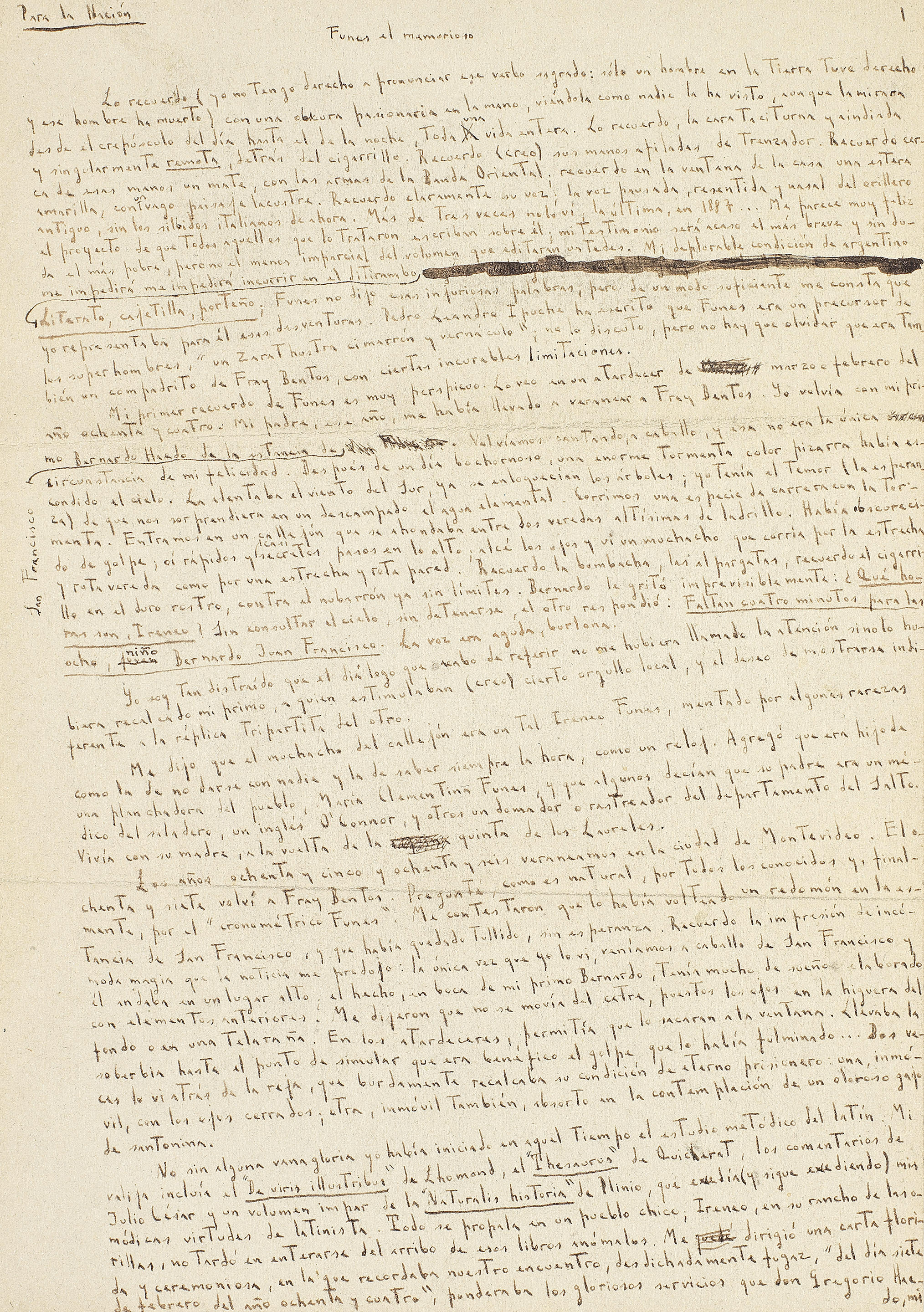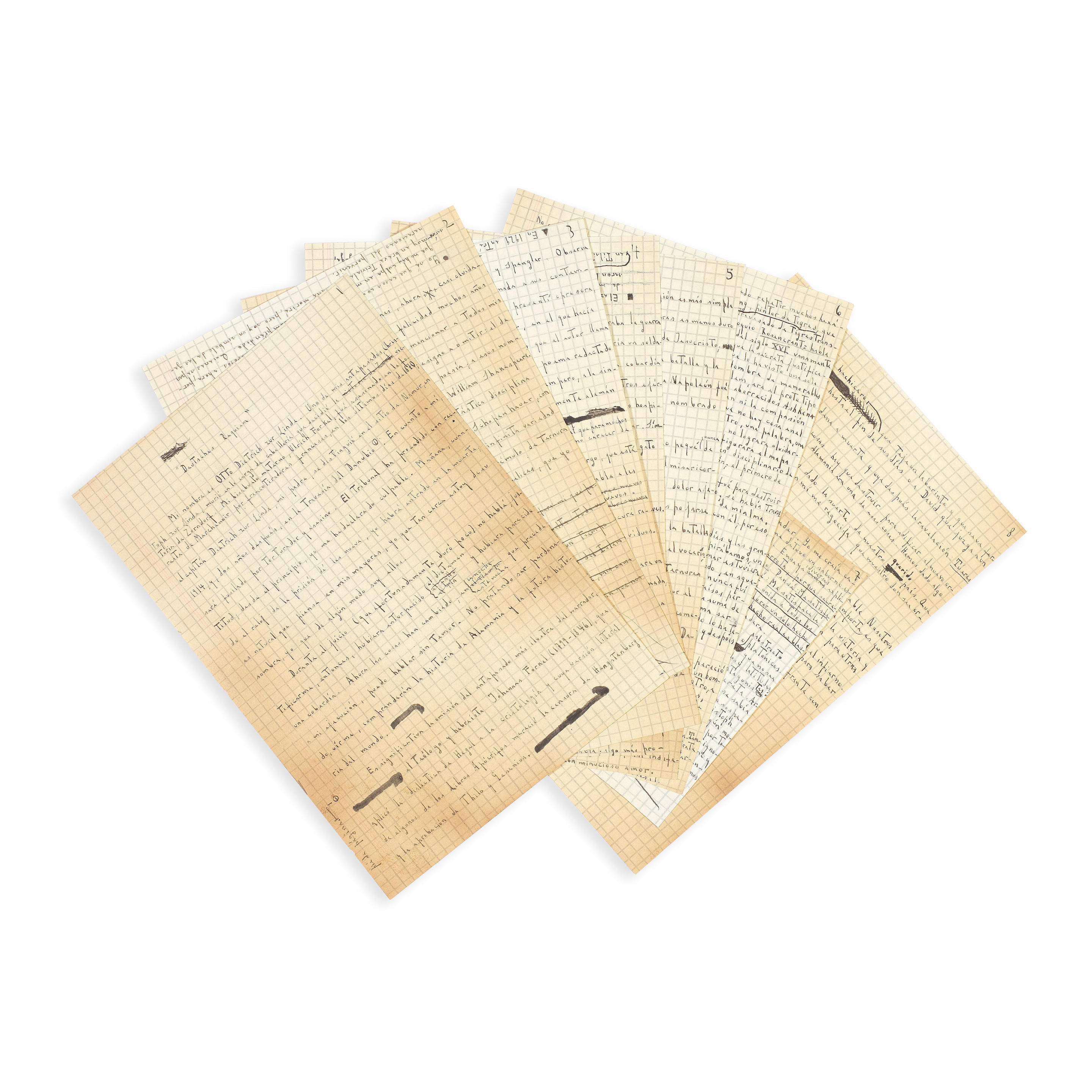BORGES, Jorge Luis (1899-1986). Autograph working manuscript draft for 'Historia del Tango', [probably before 1953], 10 numbered pages, 4to, on graph paper (removed from spiral-bound notebook).
BORGES, Jorge Luis (1899-1986). Autograph working manuscript draft for 'Historia del Tango', [probably before 1953], 10 numbered pages, 4to, on graph paper (removed from spiral-bound notebook). COMPLETE DRAFT OF BORGES' ESSAY prior to its publication in the 1955 edition of Evaristo Carriego , WITH UNPUBLISHED PARTS AND KEY VARIATIONS FROM THE PRINTED VERSION. While meticulously neat, it represents the essay in an advanced but still evolving state. The five sections are in a different order to those in the published version. Some of the marginalia record the literary sources for his reflections, forming unpublished footnotes. The margins are also filled with alternative words or phrases to those in the main text. While these tend to be adopted in the published essay, it is rare for any part of the main text to be crossed out, and two versions of a passage may even co-exist together. The opening part, evoking Martín Fierro , the epic Argentine poem by José Hernández the pampas and the gaucho, is unpublished. In it, Borges laments that Argentina's known history is solely one of wars, and that only two words in its language -- 'pampas' and 'gaucho' -- are international. Even the gaucho has been North Americanised into a cowboy, Walt Whitman calling the gaucho 'the incomparable rider of horses ... over the pampas'. A third word is tango: 'Otra es Tango.' Borges gives the unsatisfactory dictionary definition, 'Baile de sociedad importado de America en los primeros años de este siglo,' before beginning the 'Historia del Tango' itself. In the published essay, 'El culto del coraje' ('The cult of courage') is renamed 'El desafío' ('The challenge') and forms the last section. But here the illustrative story of the legendary knife fight between Wenceslao Suárez and his unknown challenger is attached to the opening paragraphs of the 'Historia del Tango'. Borges finds it a common feature of such stories that 'the challenger comes upon his ruin.' They show that men of the poorest lives had a religion with its mythology and its martyrs, 'the hard and blind religion of courage.' Their music consisted of the estilos, the milongas, the first tangos. The 'History' continues to give way to other sections. An unpublished paragraph precedes 'El Tango pendenciero' ('The fighting tango', p. 4) which explores the explicit relationship between the tango and violence. The tango and milongas directly express a conviction which many poets have sought to convey: 'la convición de que pelear puede ser una felicidad, la emoción del combate como una fiesta.' Borges entertains the idea of replacing 'convicción' by 'emoción' but crosses the latter through. He also proffers 'fiesta' as an alternative to 'felicidad'. The printed essay adopts the former word and drops the second part of his sentence entirely (though it is not crossed through in the manuscript). Joy in battle is a theme in the Iliad and Beowulf and no less in Quevedo or Victor Hugo However, 'La música es la voluntad, la pasión' ('music is the will, the passion'). Two parallel versions of the manuscript, one with amendments which were eventually published, explain the superior ability of 'the old tango' to transmit 'like music, that warlike happiness which ancient Greek and German poets tried to express verbally.' One of Oscar Wilde's dialogues shows that music can create a sense of a personal past which may never have existed. It may be the mission of the tango to give Argentines the sense of having once been brave and valorous. 'Un misterio parcial' ('A partial mystery', p. 5) emphasises that the patriotic Argentine does not identify with great leaders in his country's history but the generic figures of the gaucho and compadre. This is because the state is 'una inconcebible abstracción' ('an inconceivable abstraction'); any idea that it has moral authority is a sinister joke. After some unpublished reflections on the diffusion of the tango in London about 1910, Borges finally returns to the 'H
BORGES, Jorge Luis (1899-1986). Autograph working manuscript draft for 'Historia del Tango', [probably before 1953], 10 numbered pages, 4to, on graph paper (removed from spiral-bound notebook).
BORGES, Jorge Luis (1899-1986). Autograph working manuscript draft for 'Historia del Tango', [probably before 1953], 10 numbered pages, 4to, on graph paper (removed from spiral-bound notebook). COMPLETE DRAFT OF BORGES' ESSAY prior to its publication in the 1955 edition of Evaristo Carriego , WITH UNPUBLISHED PARTS AND KEY VARIATIONS FROM THE PRINTED VERSION. While meticulously neat, it represents the essay in an advanced but still evolving state. The five sections are in a different order to those in the published version. Some of the marginalia record the literary sources for his reflections, forming unpublished footnotes. The margins are also filled with alternative words or phrases to those in the main text. While these tend to be adopted in the published essay, it is rare for any part of the main text to be crossed out, and two versions of a passage may even co-exist together. The opening part, evoking Martín Fierro , the epic Argentine poem by José Hernández the pampas and the gaucho, is unpublished. In it, Borges laments that Argentina's known history is solely one of wars, and that only two words in its language -- 'pampas' and 'gaucho' -- are international. Even the gaucho has been North Americanised into a cowboy, Walt Whitman calling the gaucho 'the incomparable rider of horses ... over the pampas'. A third word is tango: 'Otra es Tango.' Borges gives the unsatisfactory dictionary definition, 'Baile de sociedad importado de America en los primeros años de este siglo,' before beginning the 'Historia del Tango' itself. In the published essay, 'El culto del coraje' ('The cult of courage') is renamed 'El desafío' ('The challenge') and forms the last section. But here the illustrative story of the legendary knife fight between Wenceslao Suárez and his unknown challenger is attached to the opening paragraphs of the 'Historia del Tango'. Borges finds it a common feature of such stories that 'the challenger comes upon his ruin.' They show that men of the poorest lives had a religion with its mythology and its martyrs, 'the hard and blind religion of courage.' Their music consisted of the estilos, the milongas, the first tangos. The 'History' continues to give way to other sections. An unpublished paragraph precedes 'El Tango pendenciero' ('The fighting tango', p. 4) which explores the explicit relationship between the tango and violence. The tango and milongas directly express a conviction which many poets have sought to convey: 'la convición de que pelear puede ser una felicidad, la emoción del combate como una fiesta.' Borges entertains the idea of replacing 'convicción' by 'emoción' but crosses the latter through. He also proffers 'fiesta' as an alternative to 'felicidad'. The printed essay adopts the former word and drops the second part of his sentence entirely (though it is not crossed through in the manuscript). Joy in battle is a theme in the Iliad and Beowulf and no less in Quevedo or Victor Hugo However, 'La música es la voluntad, la pasión' ('music is the will, the passion'). Two parallel versions of the manuscript, one with amendments which were eventually published, explain the superior ability of 'the old tango' to transmit 'like music, that warlike happiness which ancient Greek and German poets tried to express verbally.' One of Oscar Wilde's dialogues shows that music can create a sense of a personal past which may never have existed. It may be the mission of the tango to give Argentines the sense of having once been brave and valorous. 'Un misterio parcial' ('A partial mystery', p. 5) emphasises that the patriotic Argentine does not identify with great leaders in his country's history but the generic figures of the gaucho and compadre. This is because the state is 'una inconcebible abstracción' ('an inconceivable abstraction'); any idea that it has moral authority is a sinister joke. After some unpublished reflections on the diffusion of the tango in London about 1910, Borges finally returns to the 'H
.jpg?w=400?width=1600&quality=70)











Testen Sie LotSearch und seine Premium-Features 7 Tage - ohne Kosten!
Lassen Sie sich automatisch über neue Objekte in kommenden Auktionen benachrichtigen.
Suchauftrag anlegen